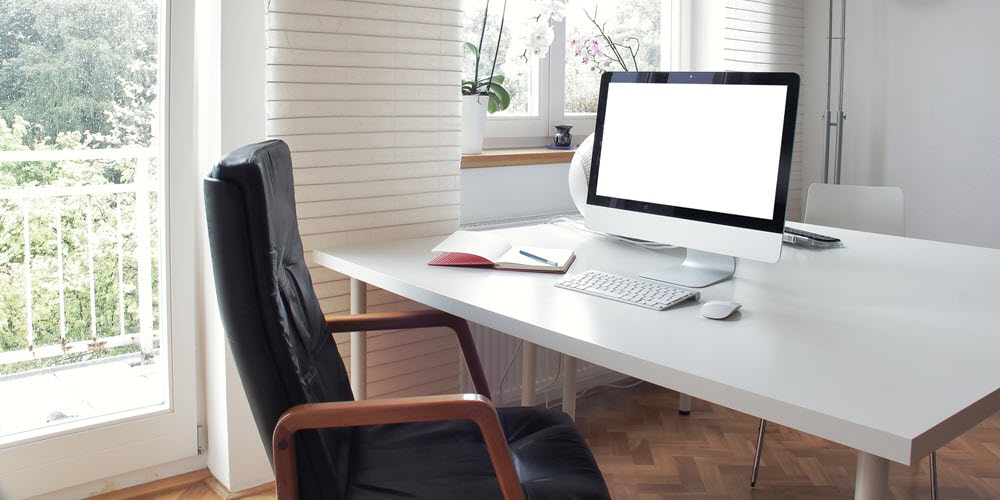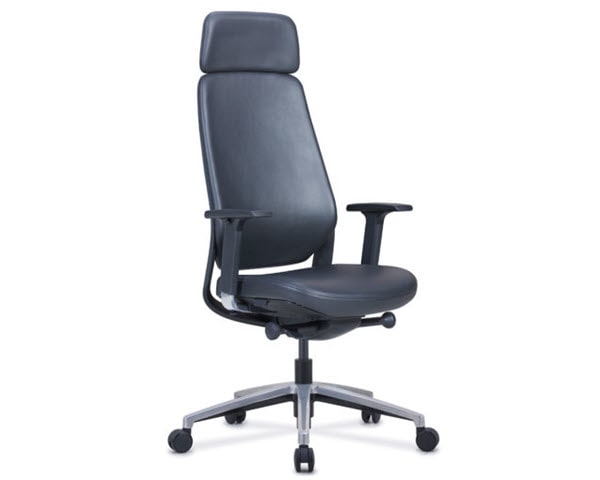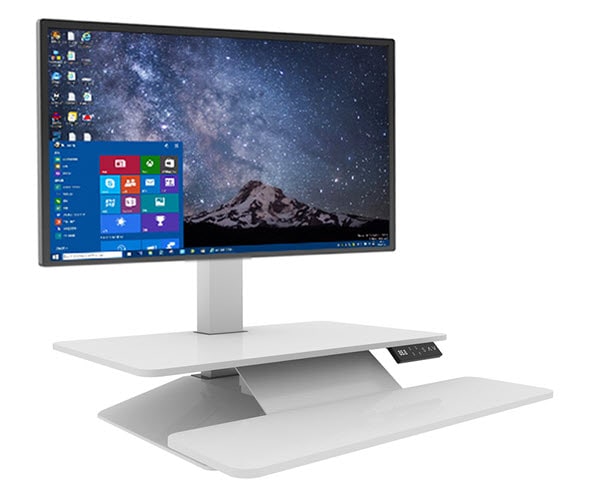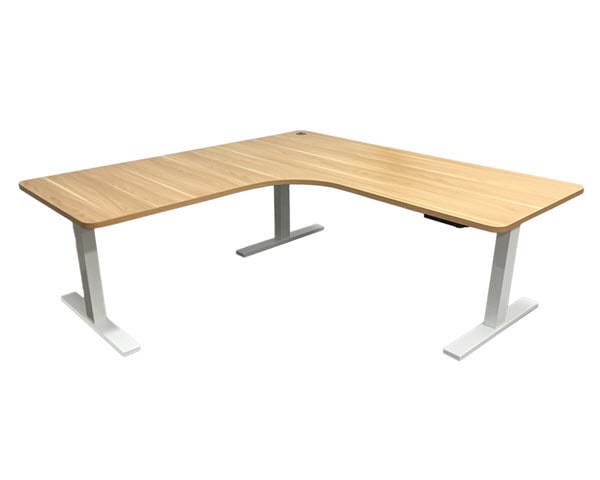
Creating an ergonomic office workstation has become a focal point for many businesses, especially when staff are working long hours from home. This is because longer hours spent in front of a computer are resulting in several health issues that can’t be ignored.
A customised workspace will help employees be more productive. You can personalise workstations to meet individual needs, matching the space they have available in their home.
The key to developing an ergonomic office workstation is maintaining a neutral, relaxed position for the worker. This minimises the stress and fatigue placed on joints and makes working comfortable. A supported back and relaxed shoulders allow for natural movement.
Ergonomic Workstation Setup
An ergonomic workstation setup is essential for employees to maintain an optimal working posture throughout the day.
Ergonomic workstations help to prevent office-work-related injuries due to poor posture and prolonged sitting. These include lower back pain, neck and shoulder pain, poor blood circulation and repetitive use injuries (e.g. in wrists and hands). Moreover, staring at a computer screen for long periods can lead to vision problems, headaches and fatigue.
Proper workstation setups help keep physical stress at bay so employees can become more productive, healthier and happier.
How to Set Up an Ergonomically Correct Workstation
For a workstation setup to be ergonomic, it must help users maintain a healthy, proper posture. It should ideally feature ergonomic furniture that’s designed to provide optimal comfort and support, preventing repetitive strain injuries and other stresses.
All aspects of a workstation are considered in an ergonomic setup for a computer workstation, including the desk, chair, computer, mouse and keyboard.
Components of an Ergonomic Workstation
The main components of an ergonomic workstation include the chair, keyboard, monitor, work surface and office environment.
- Chair: Chairs are a crucial factor in preventing back pain and boosting employee performance. A properly designed and adjustable chair provides the necessary support to the back, legs, buttocks, and arms. It also reduces the user’s need to resort to awkward postures to do their job. Whether it’s a comfortable office chair or a saddle stool, the important thing is its ergonomic design and benefits.
- Keyboard: An ergonomic computer keyboard can help reduce awkward, unnatural postures, repetitive and contact stress.
- Monitor: Since employees spend an inordinate amount of time in front of computer monitors, they should be able to modify brightness for eye comfort. Moreover, screens that can swivel horizontally and tilt vertically allow users to find the optimum angle for minimal strain.
- Work surface: All frequently used devices, such as the keyboard, mouse and phone, should be in the primary work zone (close to the body). Occasionally used devices can be placed in the secondary work zone.
- Office environment: Aside from the furnishings that comprise a workstation, the office environment can be made more conducive to health. By checking for lighting and glare, noise and smell, the office can become a more pleasant place for workers.
Start with the Right Chair for Each Employee
The right chair is comfortable while providing adequate back support. This is one aspect of an ergonomic workstation that is highly customisable, and the alignment will vary for each employee.
is comfortable while providing adequate back support. This is one aspect of an ergonomic workstation that is highly customisable, and the alignment will vary for each employee.
A chair does not need to be fancy or expensive to meet ergonomic standards. Whether you choose an office chair with or without wheels, many problems can be resolved by making a few minor adjustments to your desk chair.
When adjusting a chair, make sure its occupant is sitting up straight while comfortably resting against the seatback. The curve of the chair should support the curve of the lower back.
Leave two to three fingers’ worth of space between the seat pan and the occupant’s calves. The seat pan is located just under the seat of the chair and should never touch one’s legs while seated.
Seat height is another important detail. The seat should be adjusted so that the occupant’s knees are just below the hips and the feet are flat on the floor. A separate footrest may be needed to ensure correct posture.
Encourage employs to use the chair’s swivel mechanism to move about rather than physically twisting the body. Frequently used items should also be available within easy reach to avoid straining the back or shoulders when reaching for them.
Check out the 10 Most Comfortable Office Chairs of 2020 »
Positioning Your Computer
 Next step is to move on to your computer placement at home, as incorrect placement of the screen, keyboard and mouse can cause strains on your neck, back and wrists.
Next step is to move on to your computer placement at home, as incorrect placement of the screen, keyboard and mouse can cause strains on your neck, back and wrists.
-
Keyboard Placement
Keyboard placement is just as important as chair adjustment.
A good height for your keyboard is anywhere from one to two inches above the lap. The height of the chair and keyboard should be adjusted accordingly to ensure correct posture.
The keyboard should be slightly tilted downward or kept straight. Tilting it in an upward position can cause wrist strain, which can lead to numerous hand and wrist injuries.
-
Monitor Placement
The worker’s eyes should be aligned within the topmost quarter of the screen. This lessens the risk of developing neck strain. The monitor should also be positioned at one arm’s length from the screen.
Leaning forward to see a screen that is too far away or leaning back when one is too close can cause eye fatigue and other strain. The screen contents should be easy to see and comfortable to read, without you needing to adjust your position.
The head should be slightly tilted in a downward position. This is a comfortable and natural position for reading from the screen.
If you’re using a sit-stand office workstation layout at home, adjusting your screens can become a bit more of a hassle throughout the day. A way to make this task easy is to use a sit-stand desk converter which can adjust your screens to the required height with ease.
-
Mouse Placement
Repetitive use of the mouse can cause hand and wrist issues. Encourage your employees to take frequent breaks, such as going for a walk in their neighbourhood, making themselves some lunch or just having a quick walk away from their home office workstation.
The mouse should not be gripped tightly. A loose grip will promote more natural movement without placing undue stress on the hand.
The mouse should be moved using the shoulder and elbow muscles. Moving the hand from side to side can cause injury due to repetitive motion.
Consider a vertical mouse. This places the hand in a more neutral position.
Also, encourage employees to take frequent breaks to shake out their hands and arms. These should last for 30 seconds to one minute and will stimulate blood flow, which relieves tension.
Selecting the Right Office Desk
 To create an ergonomic office workstation in the home of each employee, it’s important to assess the available office space in their home. Rather than sticking with the usual one height office desk, adjustable workstations will allow for greater flexibility and comfort.
To create an ergonomic office workstation in the home of each employee, it’s important to assess the available office space in their home. Rather than sticking with the usual one height office desk, adjustable workstations will allow for greater flexibility and comfort.
Working solo reduces collaboration, the frequency of meetings and reasons to move from the workstation. This usually results in longer seating times in home offices compared to the usual office. Sit-Stand desk make for one of the best home office furniture items allowing employees to get up and move around more often, providing a more ergonomic office workstation overall.
-
Benefits of Corner Sit-Stand Desks
Corner (L Shape) desks provide large work surfaces while making great use of space. They help keep frequently used items within easy reach and offer a comfortable workspace. Investing in a sit-stand corner desk also allows for a more comfortable workstation when working from home.
Modules such as file cabinets and bookcases can also be added for even more versatility. This furniture is typically made to fit in small areas to maximise space.
-
Benefits of Standard Sit-Stand Desks
Sit-Stand office workstations are very popular. They promote frequent movement and natural posture while employees work.
If your employees do choose to use a standing desk, make sure it is adjusted correctly. The exact nature of this adjustment will vary from one individual to another. It could also depend on the layout of their office workstation at home.
Standard sit-stand desks can easily be adjusted to different heights, so employees can sit and stand when needed. Standing for too long can cause the legs and back to become fatigued, so encourage employees to mix it up. Suggest alternating between sitting and standing and choose desks that can be adjusted quickly.
OHS Ergonomic Workstation Requirements
Although there are no specific OHS regulations concerning workstations and seating, employers have a duty of care to their employees to ensure they have access to a safe and optimal work environment that does not pose any risks to health.
Here are some basic rules for workstations designed to achieve the goal of providing safe workspaces:
- Employees should be able to place their feet firmly on the ground or use an adjustable footrest while sitting at their workstation. The thighs should be positioned parallel to the floor, and the backrest should adequately support the lower back.
- Employees should be able to move their chair easily around their work area, and the chair base should have five points in contact with the floor.
- Chairs should be designed ergonomically and conform with Australian Standard AS/NZS 4438 for height-adjustable swivel chairs to be considered ergonomic.
- Each workstation should be arranged in a way that reduces the need to make unnatural, awkward movements to perform certain tasks.
- Employees should be instructed to stretch or take rest breaks every few minutes.
Computer Workstation Ergonomics Checklist
If you’re concerned about whether your office and employee workstations are ergonomic, you can use the following computer workstation ergonomics checklist as an initial assessment tool. The result of your survey should indicate if you need an ergonomic assessment and what adjustments need to be done to make your workplace ergonomic.
You can use the same checklist for work-from-home (WFH) workstation setups.
Provide Ergonomic Evaluations and Solutions
 Each employee’s situation will be different. Some may have experienced injuries that prohibit sitting or standing for long periods. Others may need to use certain tools to ease joint discomfort or move more easily.
Each employee’s situation will be different. Some may have experienced injuries that prohibit sitting or standing for long periods. Others may need to use certain tools to ease joint discomfort or move more easily.
Talk to your employees about their needs and seek an evaluation from a trained professional who can recommend the right tools. A comfortable office workstation will increase productivity while making work a more pleasant experience.
Customise each employee’s workspace according to preferences and needs in their home. This will vary from one individual to another. Keep in mind all situations are unique as are the solutions.
At Arteil, we carry a wide selection of office chairs that are perfect for both home and office use. Plus we offer delivery to all parts of Australia, including WA, SA, QLD, ACT, NSW, VIC, TAS and NT, so no matter where you’re located, we can deliver our chairs to you.
For advice on creating the perfect office workstation for your employees that work from home, contact Arteil today.
